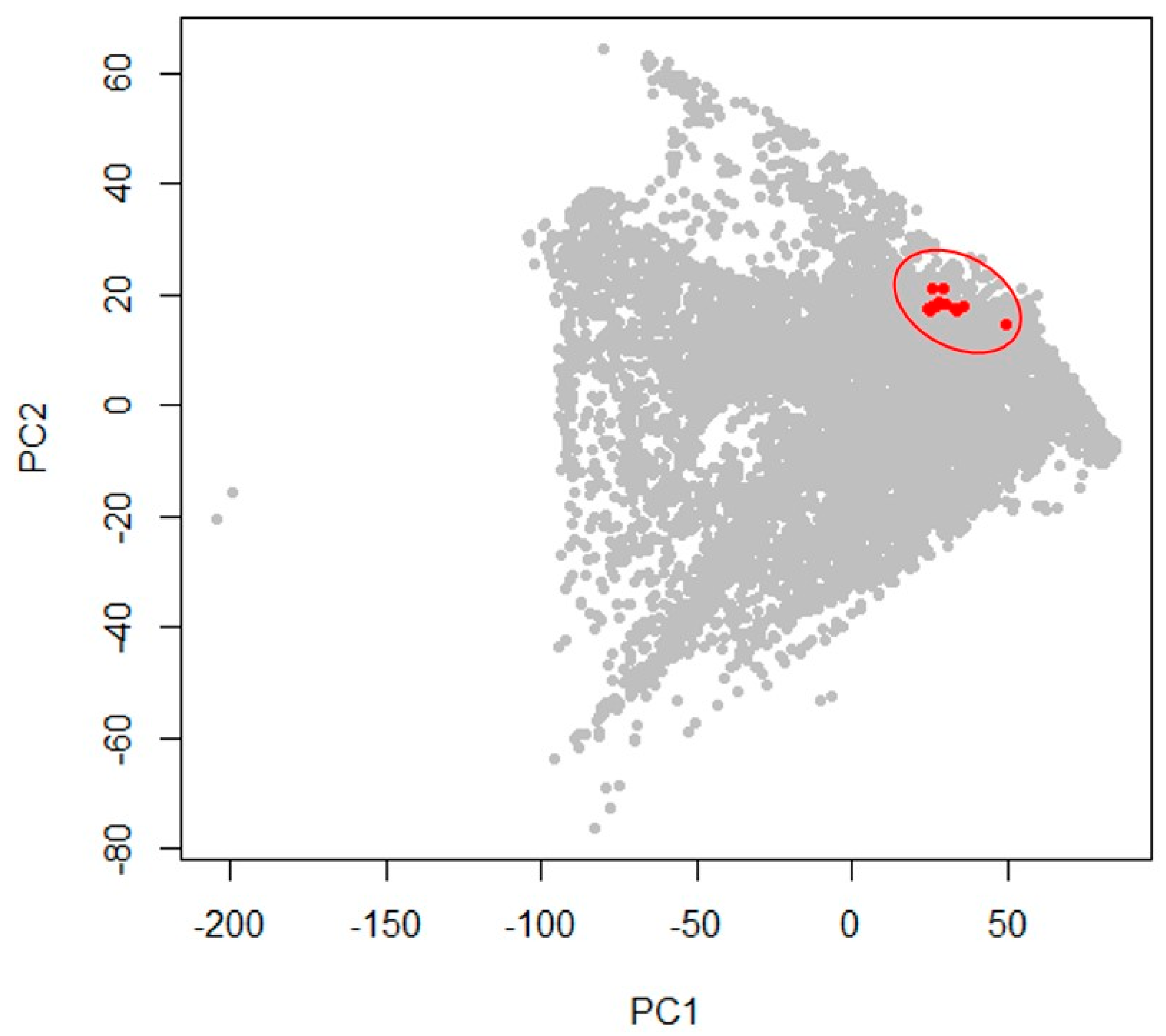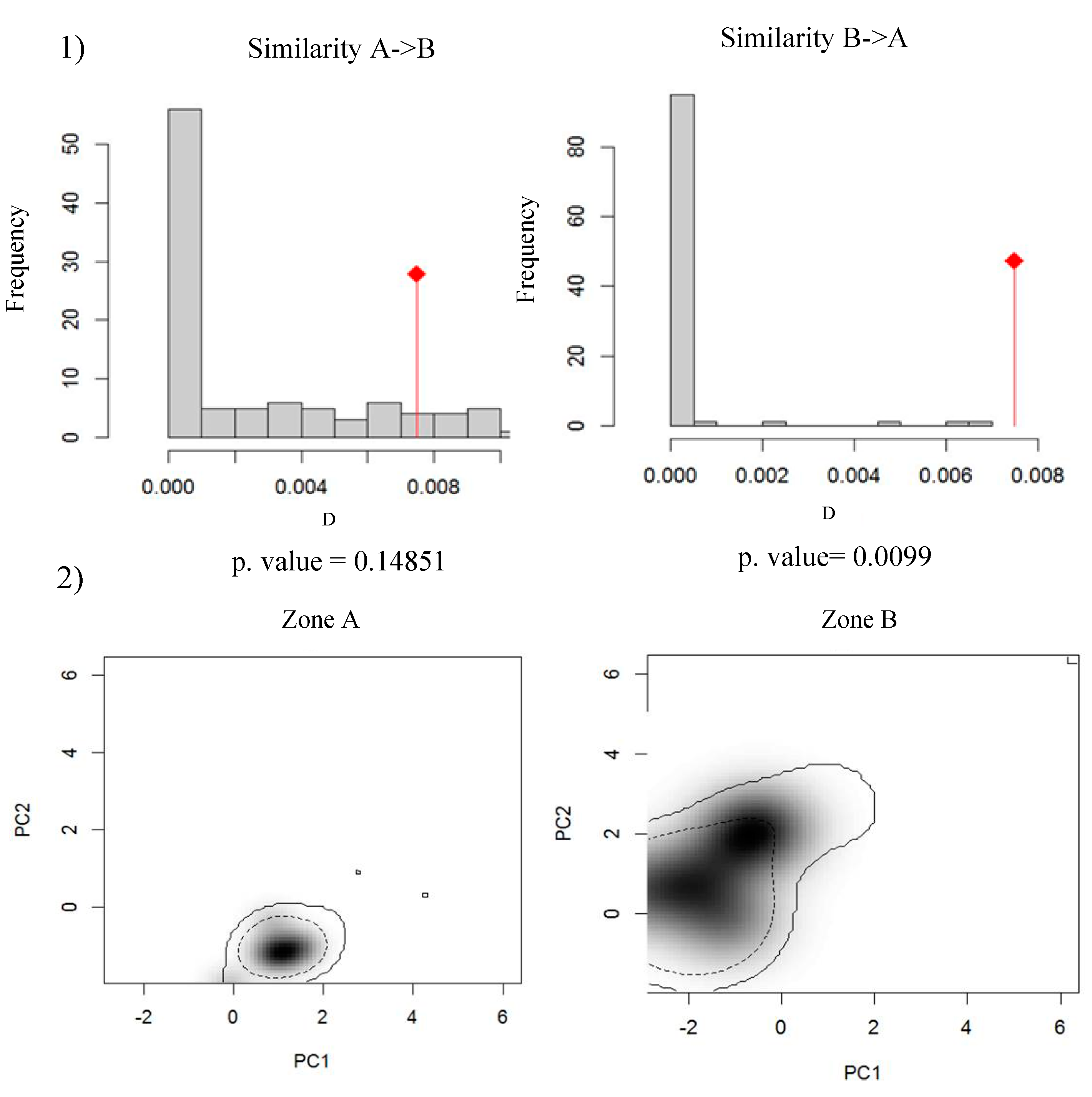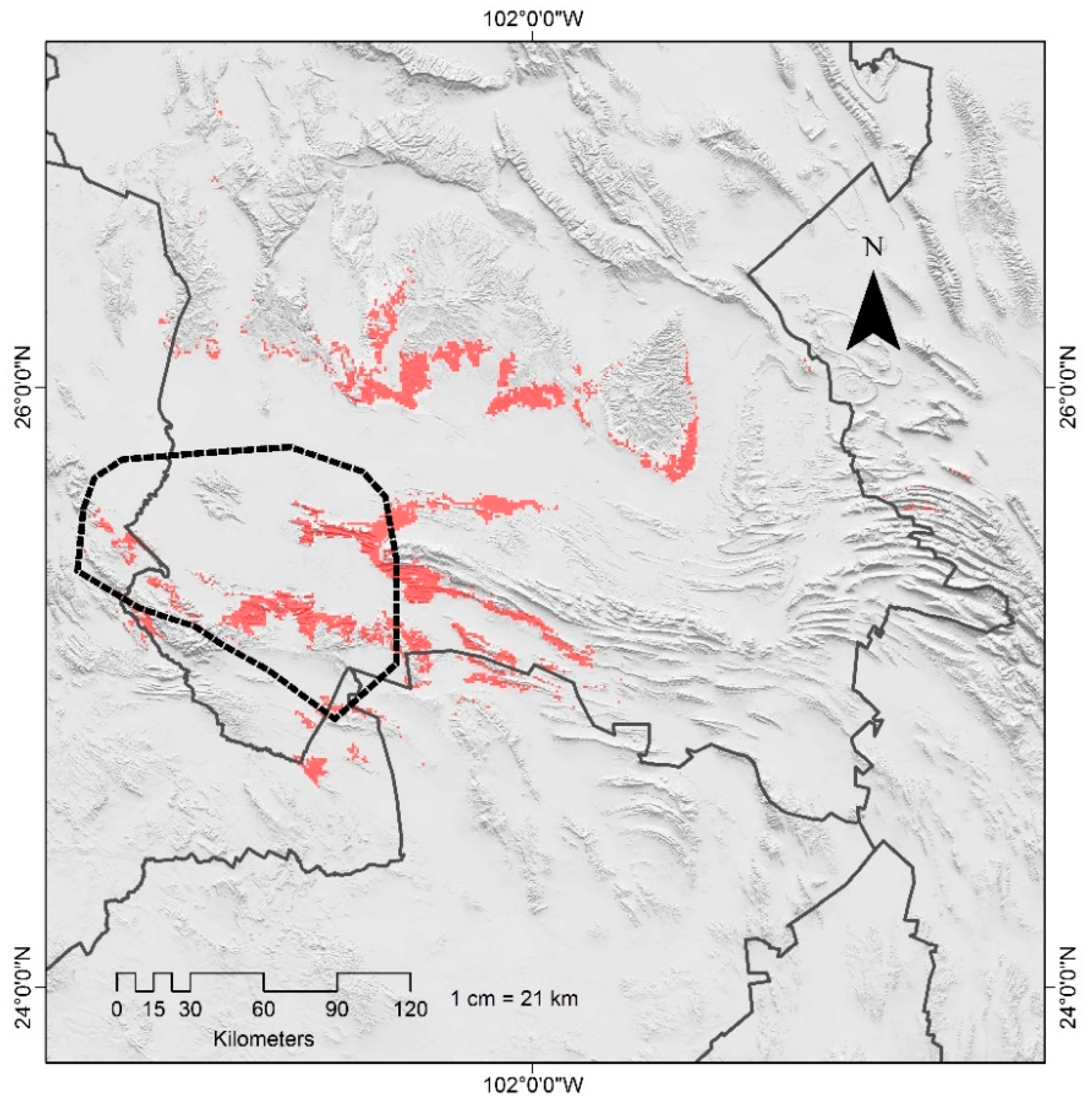Shifts in Climatic Niche Occupation in Astrophytum Coahuilense (H. Möller) Kayser and Its Potential Distribution in Mexico
Abstract
:1. Introduction
2. Materials and Methods
2.1. Geographical Records
2.2. Climatic Variables
2.3. Niche Overlap
2.4. Niche Modeling
3. Results
3.1. Climatic Variables
3.2. Niche Overlap
3.3. Niche Modeling
4. Discussion
Author Contributions
Acknowledgments
Conflicts of Interest
References
- Hernandez, H.M.; Godinez, H. Contribución al conocimiento de las cactáceas mexicanas amenazada. Acta Botánica Mexicana 1994, 26, 33–52. [Google Scholar]
- Meza-Rangel, E.; Tafoya, F.; Lindig-Cisneros, R.; Sigala-Rodríguez, J.J.; Pérez-Molphe-Balch, E. Distribución actual y potencial de las cactáceas Ferocactus histrix, Mammillaria bombycina y M. perezdelarosae en el estado de Aguascalientes, México. Acta Botánica Mexicana 2014, 108, 67–80. [Google Scholar] [CrossRef]
- Fitz-Maurice, B.; Sotomayor, M.; Fitz-Maurice, W.A.; Hernández, H.M.; Smith, M. Astrophytum coahuilense (Bonete de Obispo); Distribución Conocida; Catálogo de Metadatos Geográficos/Comisión Nacional para el Conocimiento y Uso de la Biodiversidad (CONABIO) México: 2013. Available online: http://www.conabio.gob.mx/informacion/gis (accessed on 30 November 2018). (In Spanish).
- Montanucci, R.R. Experimental Evidence for Reproductive Isolation between Astrophytum coahuilense (H. Möller) Kayser and A. Capricorne var. Senile (Fric) Okumura (Cactaceae). Haseltonia 2015, 20, 13–21. [Google Scholar] [CrossRef]
- Romero-Méndez, U.; Becerra-López, J.L.; García de la Peña, C.; Martínez-Ríos, J.J.; Czaja, A.; Muro, G.; Sánchez, J. Hydrochory in Astrophytum coahuilense: Experiment to identify seminal structures that provide its buoyancy. Polibotánica 2018, 46, 149–157. [Google Scholar]
- Fitz-Maurice, B.; Sotomayor, M.; Fitz-Maurice, W.A.; Hernández, H.M.; Smith, M. Astrophytum coahuilense (Amended Version of 2013 Assessment). The IUCN Red List of Threatened Species 2017: e.T152660A121483203. Available online: http://dx.doi.org/10.2305/IUCN.UK.2017-3.RLTS.T152660A121483203.en (accessed on 21 January 2019).
- Brown, J.H. On the relationship between abundance and distribution of species. Am. Nat. 1984, 124, 255–279. [Google Scholar]
- Johnson, C. Species extinction and the relationship between distribution and abundance. Nature 1998, 394, 272–274. [Google Scholar] [CrossRef]
- Baltzer, J.L.; Davies, S.J.; Noor, N.S.M.; Kassim, A.R.; LaFrankie, J.V. Geographical distributions in tropical trees: Can geographical range predict performance and habitat association in co-occurring tree species? J. Biogeogr. 2007, 34, 1916–1926. [Google Scholar] [CrossRef]
- Wasof, S.; Lenoir, J.; Gallet-Moron, E.; Jamoneau, A.; Brunet, J.; Cousins, S.A.; De Frenne, P.; Diekmann, M.; Hermy, M.; Kolb, A. Ecological niche shifts of understorey plants along a latitudinal gradient of temperate forests in north-western Europe. Glob. Ecol. Biogeogr. 2013, 22, 1130–1140. [Google Scholar] [CrossRef]
- Hill, M.P.; Terblanche, J.S. Niche overlap of congeneric invaders supports a single-species hypothesis and provides insight into future invasion risk: Implications for global management of the Bactrocera dorsalis complex. PLoS ONE 2014, 9, e90121. [Google Scholar] [CrossRef]
- Hutchinson, G.E. Concluding remarks Cold Spring Harbor Symposia on Quantitative Biology. Concluding Remarks 1957, 22, 415–427. [Google Scholar]
- Pearman, P.B.; Guisan, A.; Broennimann, O.; Randin, C.F. Niche dynamics in space and time. Trends Ecol. Evol. 2008, 23, 149–158. [Google Scholar] [CrossRef]
- Wiens, J.J.; Graham, C.H. Niche conservatism: Integrating evolution, ecology, and conservation biology. Annu. Rev. Ecol. Evol. Syst. 2005, 36, 519–539. [Google Scholar] [CrossRef]
- Broennimann, O.; Treier, U.A.; Müller-Schärer, H.; Thuiller, W.; Peterson, A.; Guisan, A. Evidence of climatic niche shift during biological invasion. Ecol. Lett. 2007, 10, 701–709. [Google Scholar] [CrossRef] [Green Version]
- Warren, D.L.; Glor, R.E.; Turelli, M. Environmental niche equivalency versus conservatism: Quantitative approaches to niche evolution. Evolution 2008, 62, 2868–2883. [Google Scholar] [CrossRef]
- Petitpierre, B.; Kueffer, C.; Broennimann, O.; Randin, C.; Daehler, C.; Guisan, A. Climatic niche shifts are rare among terrestrial plant invaders. Science 2012, 335, 1344–1348. [Google Scholar] [CrossRef]
- Strubbe, D.; Broennimann, O.; Chiron, F.; Matthysen, E. Niche conservatism in non-native birds in Europe: Niche unfilling rather than niche expansion. Glob. Ecol. Biogeogr. 2013, 22, 962–970. [Google Scholar] [CrossRef]
- Broennimann, O.; Fitzpatrick, M.C.; Pearman, P.B.; Petitpierre, B.; Pellissier, L.; Yoccoz, N.G.; Thuiller, W.; Fortin, M.J.; Randin, C.; Zimmermann, N.E.; et al. Measuring ecological niche overlap from occurrence and spatial environmental data. Glob. Ecol. Biogeogr. 2012, 21, 481–497. [Google Scholar] [CrossRef]
- Guisan, A.; Petitpierre, B.; Broennimann, O.; Daehler, C.; Kueffer, C. Unifying niche shift studies: Insights from biological invasions. Trends Ecol. Evol. 2014, 29, 260–269. [Google Scholar] [CrossRef]
- Wiens, J.J.; Ackerly, D.D.; Allen, A.P.; Anacker, B.L.; Buckley, L.B.; Cornell, H.V.; Damschen, E.I.; Davies, T.J.; Grytnes, J.A.; Harrison, S.P.; et al. Niche conservatism as an emerging principle in ecology and conservation biology. Ecol. Lett. 2010, 13, 1310–1324. [Google Scholar] [CrossRef] [Green Version]
- Holt, R.D. The microevolutionary consequences of climate change. Trends Ecol. Evol. 1990, 5, 311–315. [Google Scholar] [CrossRef]
- Hijmans, R.J.; Cameron, S.E.; Parra, J.L.; Jones, P.G.; Jarvis, A. Very high resolution interpolated climate surfaces for global land areas. Int. J. Climatol. 2005, 25, 1965–1978. [Google Scholar] [CrossRef] [Green Version]
- Merow, C.; Smith, M.J.; Silander, J.A., Jr. A practical guide to MaxEnt for modeling species’ distributions: What it does, and why inputs and settings matter. Ecography 2013, 36, 1058–1069. [Google Scholar] [CrossRef]
- Varela, S.; Anderson, R.P.; García-Valdés, R.; Fernández-González, F. Environmental filters reduce the effects of sampling bias and improve predictions of ecological niche models. Ecography 2014, 37, 1084–1091. [Google Scholar] [CrossRef]
- Becerra-López, J.L.; Romero-Méndez, U.; Ramírez-Bautista, A.; Becerra-López, J.S. Revisión de las técnicas para el modelado de la distribución de las especies. Revista Científica Biológico Agropecuaria Tuxpan 2016, 5, 1514–1525. [Google Scholar]
- Broennimann, O.; Petitpierre, B.; Randin, C.; Engler, R.; Di Cola, V.; Breiner, F.; D’Amen, M.; Pellissier, L.; Pottier, J.; Pio, D.; et al. Ecospat: Spatial Ecology: Miscellaneous Methods. R Package Version 1.1/2015. Available online: http://CRAN.R-project.org/package=ecospat (accessed on 30 November 2018).
- Schoener, T.W. Nonsynchronous spatial overlap of lizards in patchy habitats. Ecology 1970, 51, 408–418. [Google Scholar] [CrossRef]
- R-Core-Team. R: A Language and Environment for Statistical Computing; R Foundation for Statistical Computing: Vienna, Austria, 2015; Available online: http://www.R-project.org/ (accessed on 30 November 2018).
- Phillips, S.J.; Anderson, R.P.; Schapire, R.E. Maximum entropy modeling of species geographic distributions. Ecol. Model. 2006, 190, 231–259. [Google Scholar] [CrossRef]
- Phillips, S.; Dudik, M.; Schapire, R. MaxEnt 3.3.3k/AT&T Labs-Research; Princeton University: Princeton, NJ, USA, 2012; Available online: https://github.com/mrmaxent/Maxent/tree/master/ArchivedReleases/3.3.3k (accessed on 30 November 2018).
- Jiménez-Valverde, A.; Peterson, A.T.; Soberón, J.; Overton, J.M.; Aragón, P.; Lobo, J.M. Use of niche models in invasive species risk assessments. Biol. Invasions 2011, 13, 2785–2797. [Google Scholar] [CrossRef]
- Pearson, R.G.; Raxworthy, C.J.; Nakamura, M.; Townsend Peterson, A. Predicting species distributions from small numbers of occurrence records: A test case using cryptic geckos in Madagascar. J. Biogeogr. 2007, 34, 102–117. [Google Scholar] [CrossRef]
- Elith, J.; Phillips, S.J.; Hastie, T.; Dudík, M.; Chee, Y.E.; Yates, C.J. A statistical explanation of MaxEnt for ecologists. Divers. Distrib. 2011, 17, 43–57. [Google Scholar] [CrossRef]
- Kearney, M.; Porter, W. Mechanistic niche modelling: Combining physiological and spatial data to predict species’ ranges. Ecol. Lett. 2009, 12, 334–350. [Google Scholar] [CrossRef]
- Buckley, L.B.; Rodda, G.H.; Jetz, W. Thermal and energetic constraints on ectotherm abundance: A global test using lizards. Ecology 2008, 89, 48–55. [Google Scholar] [CrossRef]
- Warren, D.L.; Seifert, S.N. Ecological niche modeling in Maxent: The importance of model complexity and the performance of model selection criteria. Ecol. Appl. 2011, 21, 335–342. [Google Scholar] [CrossRef]
- Elith, J.; Kearney, M.; Phillips, S. The Art of Modelling Range-Shifting Species. Methods Ecol. Evol. 2010, 1, 330–342. [Google Scholar] [CrossRef]
- Moreno-Amat, E.; Mateo, R.G.; Nieto-Lugilde, D.; Morueta-Holme, N.; Svenning, J.-C.; García-Amorena, I. Impact of model complexity on cross-temporal transferability in Maxent species distribution models: An assessment using paleobotanical data. Ecol. Model. 2015, 312, 308–317. [Google Scholar] [CrossRef]
- Muscarella, R.; Galante, P.J.; Soley-Guardia, M.; Boria, R.A.; Kass, J.M.; Uriarte, M.; Anderson, R.P. ENMeval: An R package for conducting spatially independent evaluations and estimating optimal model complexity for Maxent ecological niche models. Methods Ecol. Evol. 2014, 5, 1198–1205. [Google Scholar] [CrossRef] [Green Version]
- Dambach, J.; Rödder, D. Applications and future challenges in marine species distribution modeling. Aquat. Conserv. Mar. Freshw. Ecosyst. 2011, 21, 92–100. [Google Scholar] [CrossRef]
- CONABIO. Uso de suelo y Vegetación Modificado por Conabio. Escala 1:1,000,000. Comisión Nacional para el Conocimiento y uso de la Biodiversidad: Mexico. 1999. Available online: http://www.conabio.gob.mx/informacion/metadata/gis/usv731mgw.xml?_xsl=/db/metadata/xsl/fgdc_html.xsl&_indent=no (accessed on 30 November 2018). (In Spanish).
- INIFAP-CONABIO. Edafología. Escalas 1:250,000 y 1:1,000,000. Comisión Nacional para el Conocimiento y uso de la Biodiversidad, Instituto Nacional de Investigaciones Forestales, Agrícolas y Pecuarias: Mexico. 1995. Available online: http://www.conabio.gob.mx/informacion/metadata/gis/eda251mgw.xml?_httpcache=yes&_xsl=/db/metadata/xsl/fgdc_html.xsl&_indent=no (accessed on 30 November 2018). (In Spanish).
- Anadón, J.D.; Graciá, E.; Botella, F.; Giménez, A.; Fahd, S.; Fritz, U. Individualistic response to past climate changes: Niche differentiation promotes diverging Quaternary range dynamics in the subspecies of Testudo graeca. Ecography 2015, 38, 956–966. [Google Scholar] [CrossRef]
- Thuiller, W.; Araujo, M.B.; Lavorel, S. Do we need land-cover data to model species distributions in Europe? J. Biogeogr. 2004, 31, 353–361. [Google Scholar] [CrossRef]
- Luoto, M.; Virkkala, R.; Heikkinen, R.K. The role of land cover in bioclimatic models depends on spatial resolution. Glob. Ecol. Biogeogr. 2007, 16, 34–42. [Google Scholar] [CrossRef]
- Hortal, J.; Roura-Pascual, N.; Sanders, N.J.; Rahbek, C. Understanding (insect) species distributions across spatial scales. Ecography 2010, 33, 51–53. [Google Scholar] [CrossRef]
- Early, R.; Sax, D.F. Climatic niche shifts between species’ native and naturalized ranges raise concern for ecological forecasts during invasions and climate change. Glob. Ecol. Biogeogr. 2014, 23, 1356–1365. [Google Scholar] [CrossRef]
- Dellinger, A.S.; Essl, F.; Hojsgaard, D.; Kirchheimer, B.; Klatt, S.; Dawson, W.; Pergl, J.; Pyšek, P.; van Kleunen, M.; Weber, E.; et al. Niche dynamics of alien species do not differ among sexual and apomictic flowering plants. New Phytol. 2016, 209, 1313–1323. [Google Scholar] [CrossRef]
- Becerra-López, J.L.; Esparza-Estrada, C.E.; Romero-Méndez, U.; Sigala-Rodríguez, J.J.; Mayer-Goyenechea, I.G.; Castillo-Cerón, J.M. Evidence of niche shift and invasion potential of Lithobates catesbeianus in the habitat of Mexican endemic frogs. PLoS ONE 2017, 12, e0185086. [Google Scholar] [CrossRef]
- Strubbe, D.; Beauchard, O.; Matthysen, E. Niche conservatism among non-native vertebrates in Europe and North America. Ecography 2015, 38, 321–329. [Google Scholar] [CrossRef]
- Czaja, A.; Palacios-Fest, M.R.; Estrada-Rodríguez, J.L.; Romero-Méndez, U.; Alba-Ávila, J.A. Inland dunes fauna and flora from Paleolake Irritila in the Comarca Lagunera, Coahuila, northern Mexico. Boletín de la Sociedad Geológica Mexicana 2014, 66, 541–551. [Google Scholar] [CrossRef]
- Vázquez-Lobo, A.; Morales-Aguilar, G.; Arias, S.; Golubov, J.; Hernández-Hernández, T.; Mandujano, M.C. Phylogeny and biogeographic history of Astrophytum (Cactaceae). Syst. Bot. 2016, 40, 1022–1030. [Google Scholar] [CrossRef]
- Webb, C.O.; Ackerly, D.D.; McPeek, M.A.; Donoghue, M.J. Phylogenies and community ecology. Annu. Rev. Ecol. Syst. 2002, 33, 475–505. [Google Scholar] [CrossRef]
- Ackerly, D.D. Adaptation, niche conservatism, and convergence: Comparative studies of leaf evolution in the California chaparral. Am. Nat. 2004, 163, 654–671. [Google Scholar] [CrossRef]
- Thomas, C.D.; Cameron, A.; Green, R.E.; Bakkenes, M.; Beaumont, L.J.; Collingham, Y.C.; Erasmus, B.F.; De Siqueira, M.F.; Grainger, A.; Hannah, L.; et al. Extinction risk from climate change. Nature 2004, 427, 145–148. [Google Scholar] [CrossRef] [Green Version]
- Malcolm, J.R.; Liu, C.; Neilson, R.P.; Hansen, L.; Hannah, L. Global warming and extinctions of endemic species from biodiversity hotspots. Conserv. Biol. 2006, 20, 538–548. [Google Scholar] [CrossRef]
- Huey, R.B. Temperature, Physiology, and the Ecology of Reptiles; Department of Zoology, University of Washington: Seattle, WA, USA, 1982. [Google Scholar]
- Hertz, P.E.; Fleishman, L.J.; Armsby, C. The influence of light intensity and temperature on microhabitat selection in two Anolis lizards. Funct. Ecol. 1994, 8, 720–729. [Google Scholar] [CrossRef]
- Vitt, L.J.; Zani, P.A.; Lima, A.C.M. Heliotherms in tropical rain forest: The ecology of Kentropyx calcarata (Teiidae) and Mabuya nigropunctata (Scincidae) in the Curua-Una of Brazil. J. Trop. Ecol. 1997, 13, 199–220. [Google Scholar] [CrossRef]
- Bryant, S.R.; Thomas, C.D.; Bale, J.S. The influence of thermal ecology on the distribution of three nymphalid butterflies. J. Appl. Ecol. 2002, 39, 43–55. [Google Scholar] [CrossRef] [Green Version]
- Romero-Méndez, U. Modelo Probabilístico de la Distribución Geográfico-Espacial de la Cactácea Astrophytum myriostigma LEM. (1839) en la Sierra El Sarnoso, Durango, México. Master’s Thesis, Universidad Juárez Autónoma de Durango, Venecia, Durango, México, 2006, unpublished. [Google Scholar]




| Climatic Variable | Maximum and Minimum Values |
|---|---|
| Precipitation of Warmest Quarter | 72 mm–123 mm |
| Precipitation of Coldest Quarter | 22 mm–27 mm |
| Annual Mean Temperature | 20.8 °C–21.3 °C |
| Mean Diurnal Range | 15.7 °C–17.8 °C |
| Precipitation of Driest Quarter | 12 mm–14 mm |
| Max Temperature of Warmest Month | 35.4 °C–35.7 °C |
| Variable | Contribution Percentage | Permutation Importance | Relative Importance |
|---|---|---|---|
| Alt- Elevation | 52 | 69.8 | 86.9 |
| Precipitation of Warmest Quarter | 24.9 | 0.5 | 25.15 |
| Precipitation of Coldest Quarter | 19.9 | 14.1 | 26.95 |
| Annual Mean Temperature | 2.2 | 12.7 | 8.55 |
| Mean Diurnal Range | 0.6 | 2.7 | 1.95 |
| Precipitation of Driest Quarter | 0.2 | 0.1 | 0.25 |
| Max Temperature of Warmest Month | 0 | 0 | 0 |
© 2019 by the authors. Licensee MDPI, Basel, Switzerland. This article is an open access article distributed under the terms and conditions of the Creative Commons Attribution (CC BY) license (http://creativecommons.org/licenses/by/4.0/).
Share and Cite
Cardoza-Martínez, G.F.; Becerra-López, J.L.; Esparza-Estrada, C.E.; Estrada-Rodríguez, J.L.; Czaja, A.; Ehsan, M.; Baltierra-Trejo, E.; Romero-Méndez, U. Shifts in Climatic Niche Occupation in Astrophytum Coahuilense (H. Möller) Kayser and Its Potential Distribution in Mexico. Sustainability 2019, 11, 1138. https://doi.org/10.3390/su11041138
Cardoza-Martínez GF, Becerra-López JL, Esparza-Estrada CE, Estrada-Rodríguez JL, Czaja A, Ehsan M, Baltierra-Trejo E, Romero-Méndez U. Shifts in Climatic Niche Occupation in Astrophytum Coahuilense (H. Möller) Kayser and Its Potential Distribution in Mexico. Sustainability. 2019; 11(4):1138. https://doi.org/10.3390/su11041138
Chicago/Turabian StyleCardoza-Martínez, Gabriel Fernando, Jorge Luis Becerra-López, Citlalli Edith Esparza-Estrada, José Luis Estrada-Rodríguez, Alexander Czaja, Muhammad Ehsan, Eduardo Baltierra-Trejo, and Ulises Romero-Méndez. 2019. "Shifts in Climatic Niche Occupation in Astrophytum Coahuilense (H. Möller) Kayser and Its Potential Distribution in Mexico" Sustainability 11, no. 4: 1138. https://doi.org/10.3390/su11041138





